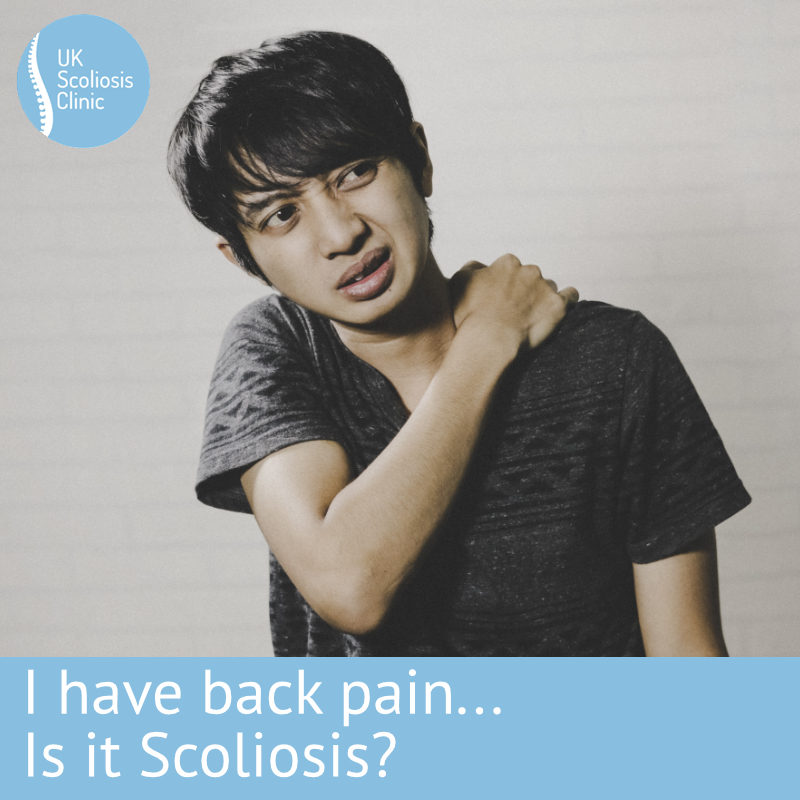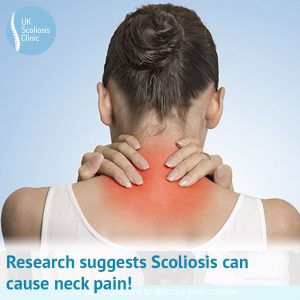
Back pain is probably the single most troublesome and common condition for people to suffer from today – our changing lifestyles as well as more time spent at a desk (or a home desk.. perhaps even worse) mean that BUPA now estimates that a many as 2 in 3 of us will suffer from back pain in our lives.[1] I began my career in spine care as Chiropractor, and proudly practice to this day. Each and every week I treat hundreds of patients for all kinds of back pain – most often it’s a common symptom, stemming from a common problem with a clear treatment pathway. Sometimes, however, back pain can be a symptom of something more serious – like scoliosis. So, could your back pain be due to scoliosis, and should you see a professional?
Does scoliosis cause back pain?
The issue of scoliosis and back pain has been somewhat contentious – many organisations will still tell you that back pain is not a symptom of scoliosis, or that scoliosis is “painless”. Today, however, these views are out of date – there’s a growing body of research that shows that while pain may not be the main symptom of scoliosis, it can certainly be a factor.
One recent study concluded that “Spinal pain is, in fact, a frequent condition in AIS patients, further supporting the need for early detection and screening to minimise potential pain and suffering”[2] and at the UK Scoliosis clinic, we support this view.
Research has also shown that in patients under 21 treated for back pain, scoliosis was the most common underlying condition (1439/1953 patients)[3] while another, involving 2400 patients with adolescent idiopathic scoliosis showed that 23% reported back pain at their initial contact[4]. Estimates suggest that scoliosis patients have between a 3 and 5 fold increased risk of back pain in the upper and middle right part of the back[5] – and support the view that chronic nonspecific back pain (CNSBP) is frequently associated with AIS, with a greater reported prevalence (59%) than seen in adolescents without scoliosis (33%)[6] It’s also been shown that patients diagnosed with AIS at age 15 are 42% more likely to report back pain at age 18.[7] – and finally, more positively, that part-time bracing in adult scoliosis cases can improve chronic pain[8]
So, can scoliosis cause back pain? Yes it can. Does that mean your back pain is caused by scoliosis? Possibly – let’s explore more.
Back pain in adults
Back pain is incredibly common in adults – as stated above, 66% of us at least will suffer from it. The vast majority of these cases will not be scoliosis. Scoliosis progression is lowest in adulthood, and the incidence of new cases is almost nil amongst the general young and middle aged adult population. It’s certainly possible that undiagnosed, untreated childhood scoliosis is the source of your pain – but there are any number of common conditions which are far more likely. If you’re aged 25 – 60, it’s highly unlikely that scoliosis will be your problem.
As we age, the picture starts to change, however – mainly due to the presence of a condition known as “de-novo” or degenerative scoliosis. De-novo scoliosis is caused by wear and tear to the spinal discs as we age, and is therefore quite common – research suggests that as many as 30% of the over 60’s suffer from de-novo scoliosis. Although de-novo scoliosis progresses much more slowly than childhood or adolescent scoliosis it can still have a major impact on quality of life, if not properly treated.[9]
To the core point of this article, while most forms of scoliosis are detected at a scoliosis specific screening, De-novo scoliosis is most often discovered as the result of a back-pain investigation. Patients with degenerative De-Novo scoliosis typically present for treatment with complaints ranging from debilitating back or lower extremity pain to spinal imbalances, as well as as a response to incidental findings on lumbar radiographs.
Counter-intuitively, the pain caused as a result of adult scoliosis is not related to the size of the curve. Several good studies show there is little to no relationship between the size of the curve and the intensity of pain – therefore a 20 degree and a 55 degree curve have the same chance of causing pain in an adult. Pain in adults is more commonly linked to the degree to which vertebrae individually shift to the side in what is called ‘lateralisthesis’ and their ‘postural balance’ or degree to which their trunk or upper body is shifted to the side or forward over their pelvis This means that a visual observation is not always sufficient to rule out scoliosis in adults, and a professional consultation is the best approach. Put simply, if you’re over 60, and suffering with new back pain – a scoliosis consultation isn’t at all a bad idea.
Back pain in Children and Young people
Finally, let’s look at the youngest population – children and teens. While we often associate back pain with older populations, this is a bit of a misconception – One meta-study from 2013 (nearly 7 years ago now) suggested a rate of low back pain among adolescents aged 9–18 years of about 12% at any given moment, whereas the number who would experience an episode of pain during a 12 month period was 34%.[10] This number certainly will not have improved!
It’s important to note that this headline figure is an average too – and the studies used in this broad-spectrum analysis showed great variation in the estimates of prevalence. For example, estimates from the Nordic countries showed a weekly occurrence of spinal pain in young people at around 20%[11], and a small Danish study showed a lifetime prevalence of spinal pain of 86% in a population of adolescents aged 11–13 years, with neck pain being the most prevalent.[12]
Scoliosis, whilst statistically less common in the young than the older, is far more risky for the young – since the opportunity for the condition to progress to the surgical threshold is greatest. Scoliosis is also known to develop rapidly and unevenly during growth spurts, making this a time for real concern. As an average figure, 3-4% of teens will develop scoliosis. Left untreated in young people, Scoliosis can be a life-limiting condition – but treated early, its impact can be almost entirely mitigated. Back pain won’t always be present in a scoliosis case – so if you have concerns about the shape of a young persons back (this is the most common way scoliosis is detected) do not be dissuaded from seeking a consultation due to the absence of back pain – but, if presented with a young person with new back pain, a scoliosis consultation may be a wise approach.
[1] https://www.bupa.co.uk/health-information/back-care/back-pain
[2] ‘Back Pain and Adolescent Idiopathic Scoliosis: A Descriptive, Correlation Study’,
Theroux Jean, Le May Sylvie, Labelle Hubert [University of Montreal, Quebec, Canada; Murdoch University, Perth, WA, Australia], Spine Society of Australia 27th Annual Scientific Meeting (8-10 April 2016)
Jean Theroux, DC, MSc, PhD, Sylvie Le May, RN, PhD, Jeffrey J. Hebert, DC, PhD,and Hubert Labelle, MD : SPINE 153607
[3] Dimar 2nd JR, Glassman SD, Carreon LY. Juvenile degenerative disc disease: a report of 76 cases identified by magnetic resonance imaging. Spine J. 2007;7:332–7.
[4] Ramirez N, Johnston CE, Browne RH. The prevalence of back pain in children who have idiopathic scoliosis. J Bone Joint Surg Am. 1997;79:364–8
[5] Sato T, Hirano T, Ito T, Morita O, Kikuchi R, Endo N, et al. Back pain in adolescents with idiopathic scoliosis: epidemiological study for 43,630 pupils in Niigata City. Japan Eur Spine J. 2011;20:274–9
[6] Jean Theroux et al. Back Pain Prevalence Is Associated With Curve-type and Severity in Adolescents With Idiopathic Scoliosis Spine: August 1, 2017 – Volume 42 – Issue 15
[7] Clark EM, Tobias JH, Fairbank J. The impact of small spinal curves in adolescents that have not presented to secondary care: a population- based cohort study. Spine (Phila Pa 1976) 2016; 41:E611–7.
[8] Scoliosis bracing and exercise for pain management in adults—a case report
Weiss et al, J Phys Ther Sci. 2016 Aug; 28(8): 2404–2407.
[9] ‘Scoliosis in adults aged forty years and older: prevalence and relationship to age, race, and gender‘
Kebaish KM, Neubauer PR, Voros GD, Khoshnevisan MA, Skolasky R, Spine 2011 Apr 20;36(9):731-6.
‘The prevalence and radiological findings in 1347 elderly patients with scoliosis‘
Hong JY, Suh SW, Modi HN, Hur CY, Song HR, Park JH., Journal of bone and joint surgery 2010 Jul;92(7):980-3
[10] Calvo-Munoz I, Gomez-Conesa A, Sanchez-Meca J (2013) Prevalence of Low Back Pain in Children and Adolescents: A Meta-analysis BMC Pediatr. 2013 (Jan 26); 13: 14
[11] Torsheim T, Eriksson L, Schnohr CW, Hansen F, Bjarnason T, Valimaa R (2010)
Screen-based activities and physical complaints among adolescents from the Nordic countries.
BMC Public Health 10:324
[12] Aartun E, Hartvigsen J, Wedderkopp N, Hestbaek L (2014) Spinal Pain in Adolescents: Prevalence, Incidence, and Course:
A School-based Two-year Prospective Cohort Study in 1,300 Danes Aged 11-13
BMC Musculoskelet Disord. 2014 (May 29); 15: 187




